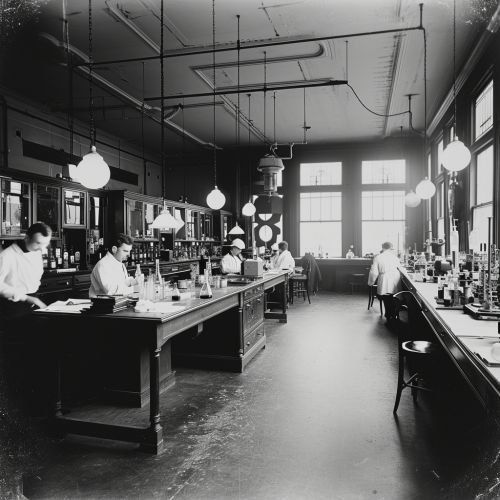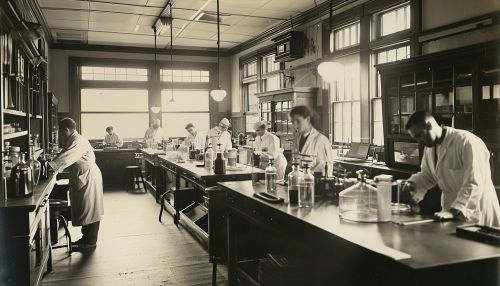Thomas Hunt Morgan
Early Life and Education
Thomas Hunt Morgan was born on September 25, 1866, in Lexington, Kentucky. He was the eldest son of Charlton Hunt Morgan, a U.S. consul, and Ellen Key Howard Morgan, a descendant of the famous American statesman, Francis Scott Key. Morgan's interest in natural history was evident from an early age, and he spent much of his childhood collecting and studying specimens from the local flora and fauna.
Morgan attended the State College of Kentucky (now the University of Kentucky) where he earned his Bachelor of Science degree in 1886. He then went on to earn his Master's degree from the same institution in 1888. During his time at the State College of Kentucky, Morgan developed a keen interest in embryology and began conducting research in this field.
In 1888, Morgan moved to Johns Hopkins University to pursue his Ph.D. under the guidance of embryologist William Keith Brooks. His doctoral thesis, titled "The Development of the Frog's Egg: An Introduction to Experimental Embryology," was a significant contribution to the field and earned him his Ph.D. in 1890.


Career and Research
After earning his Ph.D., Morgan remained at Johns Hopkins University as an associate in biology. In 1891, he was promoted to associate professor, and in 1893, he became a full professor. During this time, Morgan conducted extensive research on regeneration and embryology, particularly focusing on sea urchins and frogs.
In 1904, Morgan moved to Columbia University where he was appointed professor of experimental zoology. It was here that Morgan began his groundbreaking research on the fruit fly, Drosophila melanogaster, which would ultimately lead to his most significant scientific contributions.
Morgan chose Drosophila as his model organism due to its short life cycle, large number of offspring, and easily observable mutations. He and his students, known as the "Fly Room" researchers, conducted extensive breeding experiments to study inheritance patterns. Through these experiments, Morgan and his team were able to provide the first experimental evidence for the chromosome theory of inheritance.
In 1928, Morgan moved to the California Institute of Technology (Caltech), where he established the Division of Biology. He continued his research on Drosophila and made significant contributions to the field of developmental biology.
Contributions to Genetics
Morgan's work with Drosophila led to several key discoveries in the field of genetics. His most significant contribution was providing the first experimental evidence for the chromosome theory of inheritance, which states that genes are located on chromosomes and that these chromosomes are the carriers of genetic information.
Morgan's research also led to the discovery of sex-linked inheritance. He observed that certain traits, such as eye color, were linked to the sex of the fruit flies. This led him to propose that these traits were controlled by genes located on the sex chromosomes.
In addition, Morgan and his team discovered genetic recombination, or crossing over, a process in which chromosomes exchange segments during meiosis. This discovery was crucial in understanding the process of genetic variation.
Awards and Honors
Throughout his career, Morgan received numerous awards and honors for his contributions to the field of genetics. In 1923, he was awarded the Nobel Prize in Physiology or Medicine for his discoveries concerning the role of chromosomes in heredity. He was the first geneticist to receive this prestigious award.
Morgan was also a member of several scientific societies, including the National Academy of Sciences, the Royal Society of London, and the American Philosophical Society. In 1933, he was awarded the Copley Medal by the Royal Society of London for his outstanding contributions to scientific research.
Personal Life and Death
Morgan married Lillian Vaughan Sampson in 1904, and they had one son and three daughters. Morgan was known for his dedication to his work and his passion for genetics. He continued to conduct research and publish scientific papers well into his retirement.
Morgan died on December 4, 1945, in Pasadena, California. His contributions to the field of genetics have had a lasting impact, and he is often referred to as the "father of modern genetics."
Legacy
Morgan's work has had a profound impact on the field of genetics. His discoveries have provided the foundation for our current understanding of heredity and have paved the way for modern genetic research.
Morgan's approach to genetics, which combined careful observation with rigorous experimentation, has served as a model for subsequent generations of scientists. His work has also highlighted the importance of using model organisms in genetic research.
Today, the "Fly Room" at Columbia University, where Morgan and his students conducted their groundbreaking research, is considered a historic site in the field of genetics.
See Also
- Genetics
- Drosophila melanogaster
- Chromosome theory of inheritance
- Nobel Prize in Physiology or Medicine
